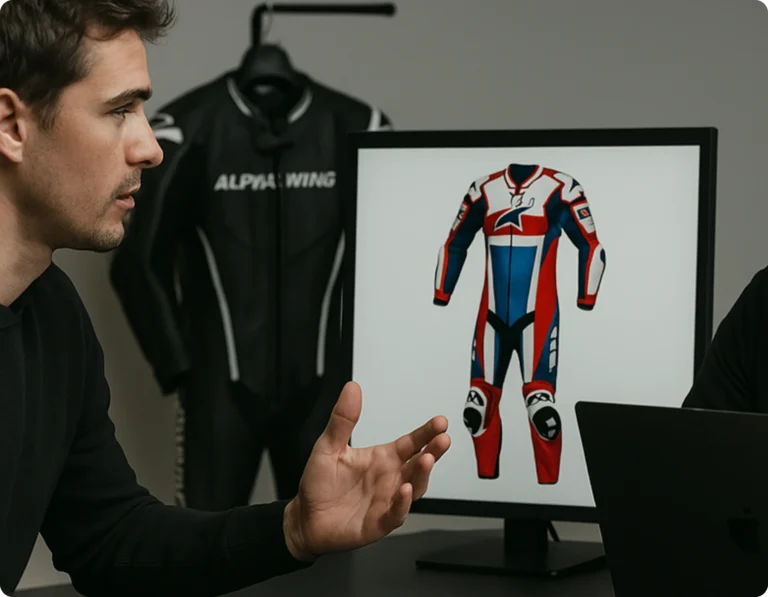Blog
Measurements to Track: Custom Racing Suit Creation Process

Crafting a truly personalized racing suit isn’t just about design—it starts with precise measurements. A well-fitted suit improves comfort, safety, and performance on the track. In this guide, we explore the Custom Racing Suit Creation Process, focusing on the essential measurements that ensure your suit fits like a second skin. We’ll show how Alpha Wing’s measurement protocol delivers elite, track-ready gear.
Custom Racing Suit Creation Process
1. Consultation & Customization
The process begins with a design consultation:
- Choose your leather type (Cowhide, Monaco cowhide, Kangaroo)
- Select suit style, perforation, hump options
- Define your branding (name, number, logo, flag)
- Decide if you want matching gloves or bootsear+2
This ensures the suit aligns with your riding style and visual identity before measurements begin.
2. Measurement Guide: Setting the Foundation
Alpha Wing provides a professional Measurement Guide for accurate data input. Here’s a summary of key measurements:
Essential Measurements:
- Neck Circumference – collar fit
- Chest, Waist, Hips – core body profiles
- Torso/Back Length – suit proportion front-to-back
- Sleeve & Outseam/Inseam Lengths – ensure comfortable reach and leg placement
Critical Limb Measurements:
- Biceps, Forearm, Upper Thigh, Calf – help tailored fit for movement zones
- Shoulder Width – enables proper panel alignment
- Loop Torso – measures torso around for racing posture comfort
Scoring these 15–20 points ensures the suit adapts to your body—even in race tuck position.
3. Why Precise Measurements Matter
A well-measured suit means:
- Perfect Fit Across Posture: prevents drag and improves aerodynamics under load
- Rider Comfort: prevents tight or loose spots that distract during the race
- Safety & Functionality: armor stays aligned even in extreme positions—especially vital during crashes
“Designed for your posture, not just your shape.”
4. Pattern Design & Revisions
Once measurements are submitted, the Alpha Wing team:
- Creates a full digital mockup
- Offers multiple design revisions to perfect aesthetics and placement tiktok.com+7AlphaWing+7AlphaWing+7
This collaborative design phase prevents post-production changes and ensures the suit matches both vision and fit.
5. Manufacturing & Quality Control
After sign-off:
- Skilled craftsmen use your measurements to craft the suit
- CE‑level armor pockets, stretch zones, perforations and seams align precisely with your anatomy
- A final quality check ensures fit, stitch quality, and armor placement are unmatched tiktok.com+3AlphaWing+3FervoGear+3FervoGear
6. Shipping & Follow-Up
Alpha Wing completes the service by:
- Shipping your suit with real-time tracking
- Offering post-delivery adjustments if needed, ensuring that the measurements taken translate to real-world comfort and function vansonleathers.com+2AlphaWing+2FervoGear+2
Conclusion
The Custom Racing Suit Creation Process hinges on measurement accuracy. From neck to calf, each measurement tells your tailor how to build a suit that moves with you—enhancing comfort, safety, and speed.
With Alpha Wing’s Measurement Guide and expert craftsmanship, you’re not just ordering a suit, you’re commissioning gear engineered for your body and racing style.
Read More How to Add Personal Branding to Your Custom Racing Suit
FAQs
Q1: What measurements are most important when creating a custom racing suit?
A: Key measurements include chest, waist, hips, inseam, arm length, and shoulder width. Additional points like knee, thigh, and neck circumference ensure a precise fit for mobility and protection.
Q2: How is a custom racing suit different from off-the-rack suits?
A: A custom suit is tailored to your exact body dimensions, riding posture, and style preferences. This results in better comfort, aerodynamics, and crash protection.
Q3: Do I need professional help to take these measurements?
A: It’s highly recommended. Tailors or fitment experts ensure accuracy, especially for complex points like crotch-to-neck or arm bend angle, which can impact suit ergonomics.
Q4: How long does the custom racing suit creation process take?
A: On average, it takes 2 to 4 weeks, depending on material selection, personalization, and approval of design mockups.
Q5: Can I update my measurements for future suits?
A: Yes! Reputable manufacturers like Alpha Wing store your data, so you can adjust or reuse measurements for future suits as your body changes.
Q6: Are adjustments possible after the suit is made?
A: Minor alterations like length or tightness can be adjusted, but major changes may require remanufacturing. That’s why accurate initial measurements are crucial.

